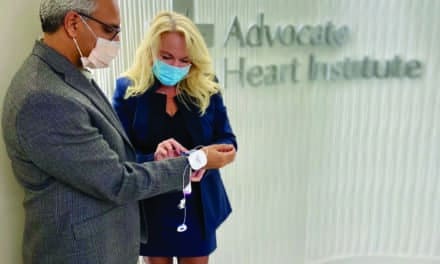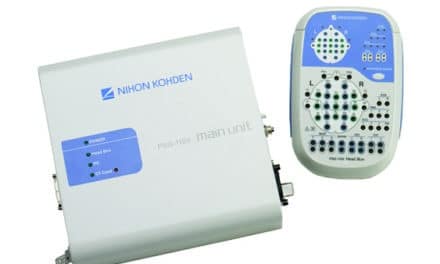Manufacturers add technologies to thwart patients who could otherwise claim false use of their diagnostic or therapy devices. Home sleep testing chain of custody solutions and oral appliance compliance trackers are two categories in which progress has been made.
Transportation workers. Veterans. Prisoners. These are several of the patient populations in which tracking sleep medicine device use is becoming increasingly prevalent. In response, more product makers—from home sleep testing (HST) to oral appliance companies—are incorporating fraud-deterrent options into their devices.
For transportation workers, the segment most often cited by manufacturers as a reason for adding tracking solutions, there is a fear (in some cases, justified) that positive sleep apnea test results or noncompliance with prescribed therapy will jeopardize a career. So some workers may decide that having a friend without sleep apnea use the equipment is lower risk. For veterans, the payer (US Department of Veterans Affairs) can require data downloads to ensure only patients with legitimate disabilities are covered. And inside prisons, there have been anecdotes of prisoners trying to steer their therapy prescription to a specific mode; for example, if they prefer an oral appliance to CPAP, they may solicit someone known to have a low apnea-hypopnea index (AHI) to take an HST in their place.
Home Sleep Testing Chain of Custody
As more markets trend toward home versus in-lab sleep testing, confirmation that the person who is intended to undergo the sleep study is truly the one whose data is recorded will become more relevant, says Andre Puleo, director of sleep diagnostics and therapy at Vyaire Medical. “Manufacturers need to play a vital role in making HST reliable and effective with growing demand for sleep diagnostics. Chain of custody plays an important role in this,” he says.
In late 2017, Vyaire launched chain of custody algorithms, coupled with a tamper-resistant bracelet, in its Noxturnal 5.2. software (compatible with its Nox T3 home sleep test). “This was developed due to the increased need for a chain of custody solution,” Puleo says. “This is very important for the clinicians to be able to confirm an accurate diagnosis, as well as for patients who need diagnosis for their sleep disorders. This is also important for payers in healthcare as this minimizes the risk of false negatives slipping through the system.”
Vyaire’s solution combines older mechanical technology in its bracelet with modern biometric technology in its algorithm. The “‘Single Body Source’ algorithm uses the patient’s own biosignals to give a clinician the data needed to verify the chain of custody. This is done by correlating the biosignals from the Nox T3 and the securely-fastened pulse oximeter,” Puleo explains. “In the case of the Single Body Source analysis detecting any deviations from the chain of custody, the Noxturnal analysis software will indicate an ‘inconclusive’ status for the chain of custody, thereby allowing the clinician to manually assess the biosignals and potentially redoing the study. Otherwise, the Noxturnal analysis software will indicate a secure chain of custody.” Meanwhile, the bracelet attaches to the patient and to the system’s pulse oximeter.
Simple mechanical-only chain of custody solutions continue to exist, and to evolve with patient needs. For example, Itamar Medical launched its chain of custody bracelet in March of 2010. “There have been several minor updates over the years (graphic design, improved snaps, and more) but the main change made was lengthening of the bracelet to accommodate patients with a larger wrist size,” say Itamar’s Efrat Litman, vice president-research & development, and Phil Dukes, vice president of sleep and clinical sales.
“The bracelet is a single-use small plastic band designed to be worn around the wrist of the hand. It contains an electronic circuit that signals to the WatchPAT [HST] device the integrity of the bracelet and a unique identification. During the night, the bracelet is connected to the WatchPAT device using a small cable (y-connector that is red and white),” Litman and Dukes say. “The technician identifies the patient and secures the bracelet to the patient’s wrist by a tamper-proof connector that ensures the bracelet will not be removed without cutting the bracelet.” Itamar says the typical clinicians using a chain of custody solution have a transportation background (such as trucking and freight train companies, as well as city/state workers), but it has also seen use within military hospitals, VAs, and prisons.
Another mechanical solution is VirtuOx’s VeriSLEEP System. It launched in February 2016 and is compatible with multiple brands of HST devices that use Nonin Medical pulse oximeters. “The system works by interrupting the pulse oximetry ground wire from the home sleep test device and routing through the VeriSLEEP connector and the VeriSLEEP band,” says Kyle Miko, founder and chief operating officer of VirtuOx. “If the system is not connected properly or if the band is cut, there will be no power to the pulse oximeter and heart rate channels, therefore not allowing the device to upload to any home sleep test software.”
VirtuOx’s technology has the option of reusable or disposable probes, “so it has a long lifetime value and can be used for testing multiple patients,” the company states in a sell sheet. It is primarily marketed as an “imposter-proof solution” to Federal Motor Carrier Safety Administration medical examiners.
At HST manufacturer CleveMed, its chain of custody debut will take the biometric route. In April 2018 the company earned a patent for a “Medical Device and Method with Improved Biometric Verification,” according to the United States Patent and Trademark Office. According to the patent, “the authentication is performed at random times during a sleep test.”
CleveMed’s Hani Kayyali, president and CEO, says, “The advantage, and the main reason behind the invention, is the inconspicuous nature of the sensor.” Because it is worn under clothing, Kayyali says it is less obtrusive to daily activities than mechanical bracelet-style systems. Wrist or neck placement of chain of custody solutions can become “a constant reminder to the patient, friends, and family of the inherent distrust in the patient’s intentions, which is unfair because the vast majority of patients have no intention of cheating the system,” he argues.
For patients who do test positive with a home sleep test, the next step is typically a prescription for therapy. While CPAP devices have a long history of objective compliance reporting, the growing alternative therapy of oral appliances does not. But a few companies are making strides.
Oral Appliance Objective Compliance Tracking
In the United States, Braebon Medical Corp’s DentiTrac is the only objective oral appliance compliance sensor available. The microrecorder, whose US commercial launch was in 2015, is sealed within biocompatible epoxy, then further sealed within the appliance. It uploads data to the cloud either from the dental office or remotely. (The infrared communication poses no risk of radiated energy, according to the company.) Richard Bonato, PhD, president and CEO of Braebon, says, “CPAP devices have benefitted from compliance measurement for years, and the recent availability of DentiTrac as the first FDA-cleared technology for objective oral appliance compliance measurement levels the field with CPAP.”
Some oral appliance manufacturers to announce the addition of DentiTrac as an option with their devices include ProSomnus Sleep Technologies, Airway Management Inc, and SomnoMed. According to Bonato, “The DentiTrac may be embedded within oral appliances using traditional acrylic or thermoform technology or newer CAD/CAM designs such as those using nylon. We have had success using all designs.” To not interfere with tongue space, Braebon recommends either the buccal sulcus or vestibule for microrecorder placement, though it has positioned DentiTrac palatally within removable orthodontic appliances without issue.
Some argue that oral appliance microrecorders such as DentiTrac (as well as other options available internationally) are inferior to CPAP data recording because while oral appliance compliance sensors track whether the patient is wearing the device and the head position, they don’t track the patient’s AHI. But some oral appliance device and accessory makers disagree.
David Kuhns, PhD, vice president of technology, ProSomnus, says, “Probably the bigger question is: What does it mean for a patient to be compliant? Considering a patient to be compliant when measured against the 4 hour/5 day a week metric does not meet the needs of treating the disease….A patient who wears an oral appliance 6 to 7 hours a night, 6 to 7 days a week with an AHI of 10 could be considered to be better treated than a CPAP patient who only wears their CPAP half the time and the remaining half is at the untreated AHI level. Half the time at an AHI of less than 5, and half the time at an AHI of 30 or higher, does not seem like compliant treatment.”
Braebon’s Bonato says, “OAT [oral appliance therapy] compliance tracking is superior to CPAP compliance tracking because one can be assured the prescribed patient is actually wearing the oral appliance, if the results show wearing. One cannot give an oral appliance with DentiTrac to a spouse or friend to wear….However, I can game any CPAP—and I have the actual data to show it—by attaching the CPAP to a simulator such as a coffee can or a balloon with a slow leak.” He adds that an oral appliance is customized to fit only the one person to whom it was prescribed, whereas any given CPAP device “can be worn by anyone.”
If Austria’s MC Technology GmbH’s rollout goes according to plan, there will soon be another objective tracker for oral appliances available in the United States. Its microchip, dubbed TheraMon, is in use in Europe and, at its American Academy of Dental Sleep Medicine Annual Meeting 2018 booth, the company said it has US labs on board to implement the chip here.
Ing. Gerhard Gschladt, MC Technology CEO, says it is working on improvements to its existing chip. At the meeting, the company showcased a prototype box that would allow for recharging of the chip’s battery (resulting in smaller and longer lasting power) while also using ultraviolet light to clean the oral appliance.
Braebon too has made improvements to DentiTrac since launch. “DentiTrac is now capable of recording therapy adherence, time, head position, and other parameters for up to 1 continuous year. The battery life expectancy is now expected to be 5 years or longer. Finally, the upload communication times have been dramatically reduced to as low as 23 seconds,” Bonato says.
As technology continues to progress, more products to ensure reliable data are sure to debut.
Sree Roy is editor of Sleep Review.




One thing that they can do is add GPS to the existing tracking. That is, in addition to what they already record, record the place of usage. Thus, if somebody living two city blocks away is using the machine (in his home), the two block discrepancy can set off alarm bells.
BTW, having somebody else take the test (or fake compliance) is “Fraudulent Impersonation,” which is a felony in all 50 states. This is on addition to whatever specific crime this might be under safety or medical statutes.